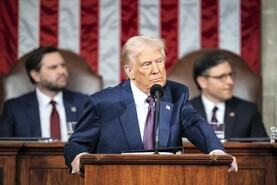When US President Donald Trump announced his ‘liberation day’ tariffs on April 2, he said it was in response to other countries taking advantage of the US by imposing their own tariffs and trade measures saying : “For decades our country has been looted, pillaged, raped and plundered by nations near and far, both friend and foe alike.”
The goal to bring manufacturing back to the US and to balance the books on trade certainly sounds laudable. But they ignore a couple of key facts. Firstly, the US does not have a jobless problem. The unemployment rate in the country was 4.1% at the end of June and there were over 400,000 unfilled positions in the manufacturing sector alone.
Secondly, the reason the US runs a trade deficit in goods is because it is generally cheaper to manufacture those goods outside the US and import them than it would be to make them at home.
This means that Trump’s solution – bringing manufacturing jobs back to the US – is for a problem that doesn’t actually exist, and if it is successful, it would mean higher costs for US consumers anyway.
However, there has recently been a fresh turn in Trump’s tariff tactics. The letters he has sent to trading partners around the world in recent weeks are generally along the lines of ‘here’s the new tariff level you will face from August 1’ with an implication that there is room for negotiation. The exception to this is the letter Trump sent to Brazil.
In that letter Trump said he was going to implement a 50% duty on imports from the country unless Brazil dropped criminal charges against its former president, Jair Bolsonaro, and reversed recent court decision curtailing the freedoms of US social media platforms such as X (formerly Twitter). This is a case of Trump using tariffs in an attempt to influence another country’s internal affairs. Add to this the fact that Brazil actually runs a trade deficit with the US, and it is clear that whatever logic which was cited in April for the introduction of new trade measures does not stand up at all with Brazil.
This latest development in how Trump is using tariffs is important as it means that he will turn to the measure to try to solve whatever international challenge he wants to solve. The threat this week of 100% tariffs on Russian exports if the country does not strike a peace deal with Ukraine is another example of Trump using a trade measure to try to solve a political problem.
For the rest of the world this means that the solution to the imposition of tariffs is about much more than the successful negotiation of a trade deal. It means that a trade deal will have to be agreed plus the country will have to do nothing to irk Trump.
Because, as the US president has shown, he will use the tariff tool to attempt to solve any problem – even those that have nothing to do with trade.
Timeline of Trump tariff threats
Since Donald Trump became US president less than six months ago, he has run roughshod through the norms of international trade which have existed since the end of the second world war and the formation of the General Agreement on Tariffs and Trade (GATT) and its successor, the World Trade Organisation (WTO).
Here’s a quick look at what he has announced – and what he has actually implemented – when it comes to trade between the US and the EU in the last few months.
17 February: Trump announces 25% tariff on steel and aluminium imports, starting from March 12. 12 March: The EU responds with the threat of countermeasures on €28bn of products from the US, including whiskey and motorcycles. 13 March: Trump threatens 200% duties on imports of champagne, wine and spirits from the EU in response to the EU countermeasures. 27 March: Trump announces 25% tariff on all car and autoparts imports.2 April: So-called ‘liberation day’ introduces 20% tariffs on all US imports. 9 April: EU introduces the countermeasures announced on 12 March, but covering a reduced €21bn of goods. 10 April: Trump reduces the blanket tariff to 10% to allow room for negotiation of trade deals. 10 April: The EU suspends countermeasures. 5 May: Trump announces 100% tariff on films produced outside the US.8 May: The EU announces fresh countermeasures package on €95bn worth of goods imported from the US.8 May: The US announces an agreement in principle on a trade deal with the United Kingdom.23 May: Trump anounces 50% tariffs on all goods from the EU to start on June 1.25 May: Trump moves deadline for 50% tariffs to July 9.4 June: Trump increases tariff on steel and aluminium to 50%. 4 June: EU reduces size of countermeasures package to €73bn.7 July: The EU is willing to accept a 10% tariff on all European products to secure a trade deal with the US. 9 July: Trump moves the tariff deadline to August 1.
11 July: Trump sends letter to the EU announcing blanket 30% tariff from 1 August. 12 July: The EU again delays the implementation of countermeasures as negotiations continue over a trade deal with the US. 14 July: The EU begins work on a fresh package of countermeasures to be rolled out if 30% tariffs are implemented on 1 August.This list is just the measures announced in the trade dispute with the EU.
On ‘liberation day’ the US president has picked trade fights with almost every trading nation in the world, and has updated, expanded or reduced the threatened level with countries depending on how negotiations are going, and how those countries react to the president’s threats.
The letter written to the EU outlining the 30% tariffs was one of 25 sent to countries and trading blocs in recent weeks.
When US President Donald Trump announced his ‘liberation day’ tariffs on April 2, he said it was in response to other countries taking advantage of the US by imposing their own tariffs and trade measures saying : “For decades our country has been looted, pillaged, raped and plundered by nations near and far, both friend and foe alike.”
The goal to bring manufacturing back to the US and to balance the books on trade certainly sounds laudable. But they ignore a couple of key facts. Firstly, the US does not have a jobless problem. The unemployment rate in the country was 4.1% at the end of June and there were over 400,000 unfilled positions in the manufacturing sector alone.
Secondly, the reason the US runs a trade deficit in goods is because it is generally cheaper to manufacture those goods outside the US and import them than it would be to make them at home.
This means that Trump’s solution – bringing manufacturing jobs back to the US – is for a problem that doesn’t actually exist, and if it is successful, it would mean higher costs for US consumers anyway.
However, there has recently been a fresh turn in Trump’s tariff tactics. The letters he has sent to trading partners around the world in recent weeks are generally along the lines of ‘here’s the new tariff level you will face from August 1’ with an implication that there is room for negotiation. The exception to this is the letter Trump sent to Brazil.
In that letter Trump said he was going to implement a 50% duty on imports from the country unless Brazil dropped criminal charges against its former president, Jair Bolsonaro, and reversed recent court decision curtailing the freedoms of US social media platforms such as X (formerly Twitter). This is a case of Trump using tariffs in an attempt to influence another country’s internal affairs. Add to this the fact that Brazil actually runs a trade deficit with the US, and it is clear that whatever logic which was cited in April for the introduction of new trade measures does not stand up at all with Brazil.
This latest development in how Trump is using tariffs is important as it means that he will turn to the measure to try to solve whatever international challenge he wants to solve. The threat this week of 100% tariffs on Russian exports if the country does not strike a peace deal with Ukraine is another example of Trump using a trade measure to try to solve a political problem.
For the rest of the world this means that the solution to the imposition of tariffs is about much more than the successful negotiation of a trade deal. It means that a trade deal will have to be agreed plus the country will have to do nothing to irk Trump.
Because, as the US president has shown, he will use the tariff tool to attempt to solve any problem – even those that have nothing to do with trade.
Timeline of Trump tariff threats
Since Donald Trump became US president less than six months ago, he has run roughshod through the norms of international trade which have existed since the end of the second world war and the formation of the General Agreement on Tariffs and Trade (GATT) and its successor, the World Trade Organisation (WTO).
Here’s a quick look at what he has announced – and what he has actually implemented – when it comes to trade between the US and the EU in the last few months.
17 February: Trump announces 25% tariff on steel and aluminium imports, starting from March 12. 12 March: The EU responds with the threat of countermeasures on €28bn of products from the US, including whiskey and motorcycles. 13 March: Trump threatens 200% duties on imports of champagne, wine and spirits from the EU in response to the EU countermeasures. 27 March: Trump announces 25% tariff on all car and autoparts imports.2 April: So-called ‘liberation day’ introduces 20% tariffs on all US imports. 9 April: EU introduces the countermeasures announced on 12 March, but covering a reduced €21bn of goods. 10 April: Trump reduces the blanket tariff to 10% to allow room for negotiation of trade deals. 10 April: The EU suspends countermeasures. 5 May: Trump announces 100% tariff on films produced outside the US.8 May: The EU announces fresh countermeasures package on €95bn worth of goods imported from the US.8 May: The US announces an agreement in principle on a trade deal with the United Kingdom.23 May: Trump anounces 50% tariffs on all goods from the EU to start on June 1.25 May: Trump moves deadline for 50% tariffs to July 9.4 June: Trump increases tariff on steel and aluminium to 50%. 4 June: EU reduces size of countermeasures package to €73bn.7 July: The EU is willing to accept a 10% tariff on all European products to secure a trade deal with the US. 9 July: Trump moves the tariff deadline to August 1.
11 July: Trump sends letter to the EU announcing blanket 30% tariff from 1 August. 12 July: The EU again delays the implementation of countermeasures as negotiations continue over a trade deal with the US. 14 July: The EU begins work on a fresh package of countermeasures to be rolled out if 30% tariffs are implemented on 1 August.This list is just the measures announced in the trade dispute with the EU.
On ‘liberation day’ the US president has picked trade fights with almost every trading nation in the world, and has updated, expanded or reduced the threatened level with countries depending on how negotiations are going, and how those countries react to the president’s threats.
The letter written to the EU outlining the 30% tariffs was one of 25 sent to countries and trading blocs in recent weeks.






 This is a subscriber-only article
This is a subscriber-only article










SHARING OPTIONS: